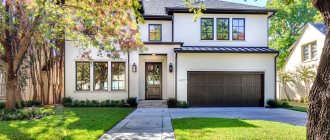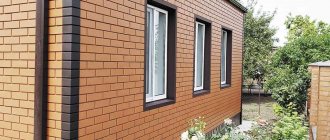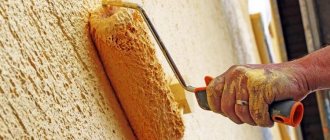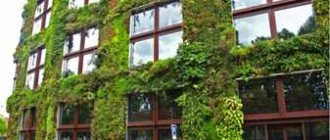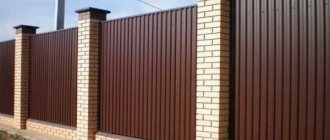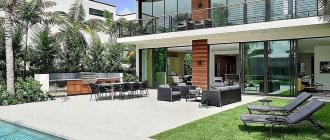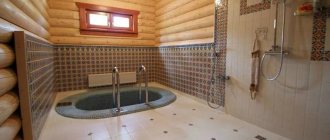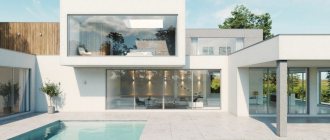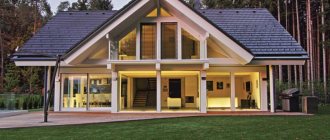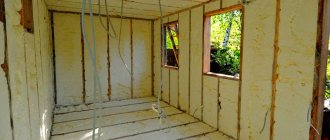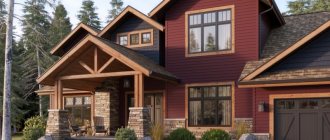Speaking about finishing the facades of houses, many wondered, with what? There are many options, but one that really deserves attention is siding or panel siding. We can safely say that this is the most popular material for decorating the walls of the facades of suburban and rural houses, estates and cottages.
Of course, any type of siding copes well with many problems: it protects the house from climatic disasters, it is strong, durable and incredible in its external characteristics. After all, with the help of this particular building material it is easy to create the texture of wood and stone. It is so popular due to its simplicity in operation, since anyone can handle it with minimal construction skills. But few people know how to distinguish between siding and which type is most suitable for it.
First, let's figure out WHAT IS THIS?
ADVANTAGES OF SIDING PANELS
Let's look at what the priority of siding is and why most people choose it. One of the many advantages of this material is its protective effects. The facade of your house will be protected from rain, wind and snow with its help.
If you want to choose a material that will be economical, siding will certainly suit you, because this material will be cheaper than most, easy to use and install, and will last for a long time.
But we cannot ignore one of the most pleasant priorities of siding - external properties. There is such a wide selection of siding on the market that everyone, even a very picky buyer, can find the ideal option for themselves. And even ordinary facades can look elegant and stylish with siding in combination with landscaping.
ASTM standard
There is no specific GOST standard for manufacturing, so it is customary to rely on a different standard. Its criteria are as follows:
- The tensile strength of the material is no more than 422 kg/m2.
- Withstands heating of at least 88 C.
- Fire spreads at a speed of no higher than 25 m/s, and smoke emissions - 400.
These characteristics ensure the fire-fighting properties of the material.
TYPES OF SIDING FOR THE HOME
If you still decide to use siding, one of the most important missions will be choosing it between all its varieties. Each type of façade design will differ in its properties. All of them are durable and provide different loads on the mounting elements that cling to the wall.
Some require very meticulous care, while others do not need it at all. In any case, it is better to coordinate your choice with an architect, or a person who has the skills and knowledge of the device and all its properties.
Finish options
Moving away from the performance characteristics and protective properties of the siding material, it is worth paying attention to the appearance of the building, which will be achieved through the panels. There are a great variety of finishing options, since the range of this material allows any imagination and fantasy to be realized .
In addition to the fact that it is possible to combine several colors of material on the facade of a building, you can purchase panels of different textures and, for example, create an imitation of wood, brick or stone.
Regarding finishing options based on installation technology, there are two of them:
- vertical;
- horizontal.
With the help of vertical installation of siding panels, the facade of the house is visually stretched, the height of the wall becomes visually larger. Horizontal finishing creates a single, holistic system that looks harmonious and cozy.
IMPORTANT!
To create a more expressive and brighter facade of the house, you can use dark-colored siding on the corners of the building.
EXTERIOR VINYL SIDING
The first and most common type is vinyl. It consists of polyvinyl chloride panels that come in different sizes. PVC siding very successfully imitates wood texture, natural stone or brickwork.
There are an endless number of colors and textures. Vinyl siding imitating wood looks especially beautiful due to its variety and effects. And also stone siding. Vinyl siding can be selected to suit every taste and style of building, which will fit into every surrounding area.
Advantages of vinyl siding:
- There is a very diverse range of colors and a large number of textures on the market.
- very wide operating temperature range from -50 to +50.
- Vinyl siding is very lightweight, so it does not require strong fasteners.
- it is not exposed to precipitation.
- very good price on the market.
The disadvantages of vinyl siding are:
It is equally important to know about the disadvantages of vinyl. One of the important disadvantages will be the coefficient of linear expansion of vinyl, which must be taken into account when installing siding in order to protect the material from deformation, as this is possible due to temperature changes.
Due to its light texture, vinyl material is highly likely to suffer mechanical damage. Due to this factor and a number of others, vinyl siding has a relatively short service life.
Finishing the Facade of a House with Vinyl Siding – Not the Best Facing Option
Vinyl is a synthetic home exterior material that has become popular due to its easy maintenance, versatility, durability and low cost. It is available in many colors and in different shapes such as vertical panels, tiles, horizontal panels, fish scales, circle. It can be made to look like other natural materials such as stone and tiles.
Advantages:
- It is low maintenance and only requires occasional washing.
- Vinyl siding does not require installation by a professional and is easy to install with your own hands for exterior cladding of the house.
- It can come in various shapes, textures and colors.
Flaws:
- Vinyl siding has a synthetic appearance, which can be discouraging for those who prefer the natural look.
- Vinyl siding is detrimental to the environment once removed because it is non-biodegradable and remains in the landfill for a very long time unless reused.
- it can be damaged by extreme weather conditions such as wind and high temperatures
- vinyl siding from cheap manufacturers just stinks and fades very quickly, especially on the sunny side of the house
Material price:
- $4-12 per sq.m.
Part of what makes it so attractive to consumers is its versatility. Vinyl siding is available in a huge variety of styles. Imitation of other materials such as wood and brick is very common. Like wood, vinyl siding has several different installation options to help you fine-tune your custom fit to your personal preferences.
The most common installation methods for vinyl include:
- Horizontal - a series of thin strips are placed horizontally in rows.
- Vertical - a series of thin strips are placed vertically in rows. Alternatively, a series of thin stripes are broken into wide stripes in a repeating manner.
- Lap – Thin, lightweight pieces of vinyl overlap slightly with tapered edges.
Add in the relatively low cost for both materials and installation, and it's even easier to see why budget-conscious buyers are choosing vinyl siding as their siding material.
That's not all there is to love about vinyl siding. Additional benefits include a reasonable 40-year post-installation warranty from top manufacturers. Not that you need it - vinyl is extremely durable. It lasts for decades on end with little signs of wear and maintenance. All that is required for cleaning is regular rinsing.
Vinyl is also known and loved for its energy efficiency. Add an insulated version to your home and you can save a ton of money on your utility bills in both hot and cold climates.
Despite all the great advantages, vinyl siding has its disadvantages. Chief among these disadvantages is that vinyl is not waterproof. Although it is water resistant, poor installation often causes water to seep behind pieces of vinyl and cause damage to the wood underneath. Buying the wrong vinyl siding is another problem. Those who live in very hot or cold climates must choose their panels wisely. Otherwise, their vinyl panels may become warped. The vinyl siding color you choose is a home color you will have forever. At least until you decide to replace the panels completely.
Main cladding elements
- Facing material - siding. Wood, wood, vinyl or metal. Up to 6 meters long and at least 140 mm wide.
- Ventilation system. It consists of ventilation gaps ranging in size from 40 to 100 mm, located in the distance of the base, above and below the windows, under the cornice.
- Thermal insulation. For a free-standing summer gazebo, insulation may not be necessary. Extensions to the house, as well as verandas and terraces that are used all year round need thermal insulation. Mineral wool with a thickness of 150 to 250 mm is used as insulation. Mineral wool slabs are attached to dowel anchors.
- Fastening system. Includes brackets supporting vertical and horizontal profiles. The brackets form a frame onto which the profile is attached and the siding is mounted using fasteners.
- Decorative or shaped frames. Structural elements in the color of the siding, used to frame the parapet, window and door connections, the base of the gazebo or veranda.
WOODEN SIDING – WOOD SIDING, LOG, BEAM
The following type of siding is ideal for houses located near a forest or included in green landscaping - rural homesteads, cottages, country houses. Of course, this is wood siding. The question immediately arises of protecting the tree from the proliferation of parasites and mold? To protect your home from this problem, wooden siding is dried very well when manufactured in a factory or treated with special antiseptics.
Advantages of wood siding:
Let's highlight all the advantages of wooden panels. First of all, it is environmentally friendly, because wood is a natural material that will give a very aesthetic appearance to your home due to the high quality of the wooden texture. And also good thermal insulation.
If we talk about disadvantages, the first disadvantage of wood siding panels will be similar to vinyl - not durability. Wooden panels are not a cheap pleasure for the client, and one should not forget about constant maintenance (painting). And the last, no less important disadvantage is the fire hazard and tendency to deformation.
Model for covering the plinth
The most durable of all the options presented is a thickness of 3 mm or more. The manufacturing technology provides for the use of high-quality and dense materials to provide sufficient support for the base.
It is an excellent choice for external cladding, as it allows you to imitate brick or decorative stone.
METAL SIDING – METAL SIDING
If you need a strong and durable material for cladding your house, we recommend choosing metal siding. It comes in several types: steel, aluminum and zinc. Typically, clients who plan to use metal siding prefer aluminum siding, since it can be painted in any color, or even create the texture of wood.
Advantages of metal siding:
So, the advantages of metal siding, as mentioned above, are durability. The reason for this is the metal’s very high resistance to temperature changes and protection from natural disasters due to its strength. Another very positive feature is that metal structures do not have problems with microflora and do not create mold.
If we compare all types of metal siding, then aluminum siding will definitely be inferior to durable zinc and steel. Once damaged, the crumpled part of the aluminum cannot be repaired. However, there is one drawback common to all three types of metal siding - very low sound insulation during rain. It is also impossible not to mention corrosion, which greatly threatens the metal at the joints.
What should not be used in the exterior
To create a truly attractive home exterior, you need to be aware of common mistakes that non-experts make. Here are the main ones:
- using more than three shades;
- purchasing materials of different colors without evaluating real samples, only based on photos;
- purchasing in small quantities, when you may come across shades from different batches with differences in tone;
- choosing a color without taking into account the location of the building in the cardinal directions: for example, if you buy a dark tone for a house with walls facing south, standing in an open area, the material will quickly fade;
- the color is chosen without taking into account the mood that it evokes in you (if red seems too aggressive to you, and gray makes you sad, you should not use them for your home, even if “stylists recommend”).
Now you know about all the main recommendations.
FIBER CEMENT SIDING
The last and most profitable type of siding is fiber cement. It contains the best quality cement, sand, water and cellulose fibers. It is these ingredients that make it environmentally friendly and a worthy replacement for decorative stone.
Fiber cement siding is an ideal alternative to vinyl siding, but it looks better and more natural, and is also quite easy to install. You don’t have to worry about the shortcomings that wood and metal have - fiber cement siding is not endowed with them.
Advantages of fiber cement siding:
If we talk briefly about the main advantages of fiber cement siding, then all the disadvantages of other types are taken into account and become advantages. It is non-flammable and does not require maintenance like wood. Also, do not worry about high temperature changes and climatic elements; this material is very durable and reliable.
Generalization on the topic
So, let’s summarize and answer the question posed by the topic of the article - what is the best siding to cover a house with. The choice is usually based on the strength of the product and its long-term operation. That's why:
- Vinyl siding changes its dimensional parameters under the influence of temperature changes. Therefore, in the installation instructions, the manufacturer always mentions that the sheathing material should not be fully attached to the frame. That is, the screws are not screwed in all the way. This gap allows the material to expand and contract.
- The metal variety is susceptible to corrosion. Especially in pruning areas. At the same time, metal products made from thin steel sheets are afraid of shock loads, under the influence of which they lose their presentable appearance.
- The wooden version is inferior to all others in terms of fire hazard. In addition, this variety has the shortest service life, even if it is treated with protective compounds every year.
- Fiber cement siding and its ceramic counterpart are heavy, which requires large investments in the construction of the frame.
Incorrect installation led to warping of the cladding Source makebestphoto.ru
SIDING INSTALLATION – INSTALLATION FEATURES
Installing the siding is the last step you will need to go through. However, few people know that anyone who has at least the minimum set of necessary construction tools can install it with their own hands.
The technical and external characteristics of siding will allow you to perfectly and uniquely design your home, even in the most difficult areas (corners and holes). The structure, decorated with siding, will resemble an impeccable house, which is made of natural wood, the base is made of decorative stone.
Tools and materials
The list of tools includes:
- scaffolding or stepladder - for working at heights;
- building level - to check horizontality;
- drill or screwdriver - for drilling holes for fasteners;
- tape measure - for taking measurements;
- lever screwdriver - for tightening bolts;
- hand saw - for cutting;
- riveting pliers - for installing rivets.
The siding of the terrace is done using the elements of the cladding system:
- metal brackets KKU-90 (120, 150, 180, 230). with washer and insulating gasket;
- guide profiles KPG-40x40x3000 or L-shaped KPG-60x44x3000;
- shaped elements: initial (starting), corner, additional, finishing, casting strips;
- siding panels;
- mineral wool slabs.
Fasteners used:
- self-tapping screws 4.2x16 galvanized with a press washer;
- steel rivets.
Instructions: how to cover a veranda with siding with your own hands
Imitation of natural wood
A polyethylene film with a pattern of wood panels is glued onto a durable vinyl base. The model has a smooth surface, a variety of shades - from light brown to walnut.
For decoration, this option will be an excellent solution, since the imitation is almost impossible to distinguish from real wood.
Imitation of log beams
Another of the original options for the external cladding of a private house. It is most often used for decorative decoration of buildings made of old bricks or blocks that have ugly facades.
Models with an imitation of galvanized timber are presented to the attention of buyers on the building materials market. They are distinguished by their original decor, rich color and texture.
It should be remembered that the cost of the material is higher compared to previous models.
H-profile assembly
The H-profile allows you to neatly join the panels in the longitudinal direction. Its installation is completely similar to the installation of corner profiles.
The choice of location for H-profiles is dictated by the aesthetic considerations of the owner - they can be installed symmetrically, ensuring the same length of panels, or use some entire panels, trimming another span.
Auxiliary models
These types of material are used to form joints, strengthen starting and finishing strips, window trims and wind structures.
There are no special decorative requirements for this type of cladding material, but the practical component plays an important role. The main task of auxiliary siding is to maximize the strengthening of construction joints and seams.
